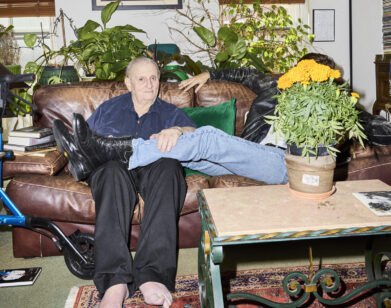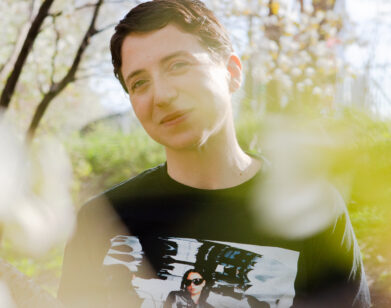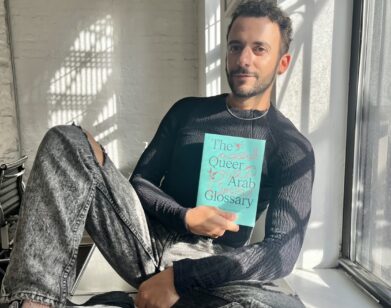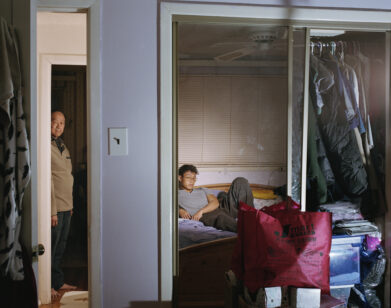Benjamin Moser and Gary Indiana Onthe Dark Brilliance of Susan Sontag
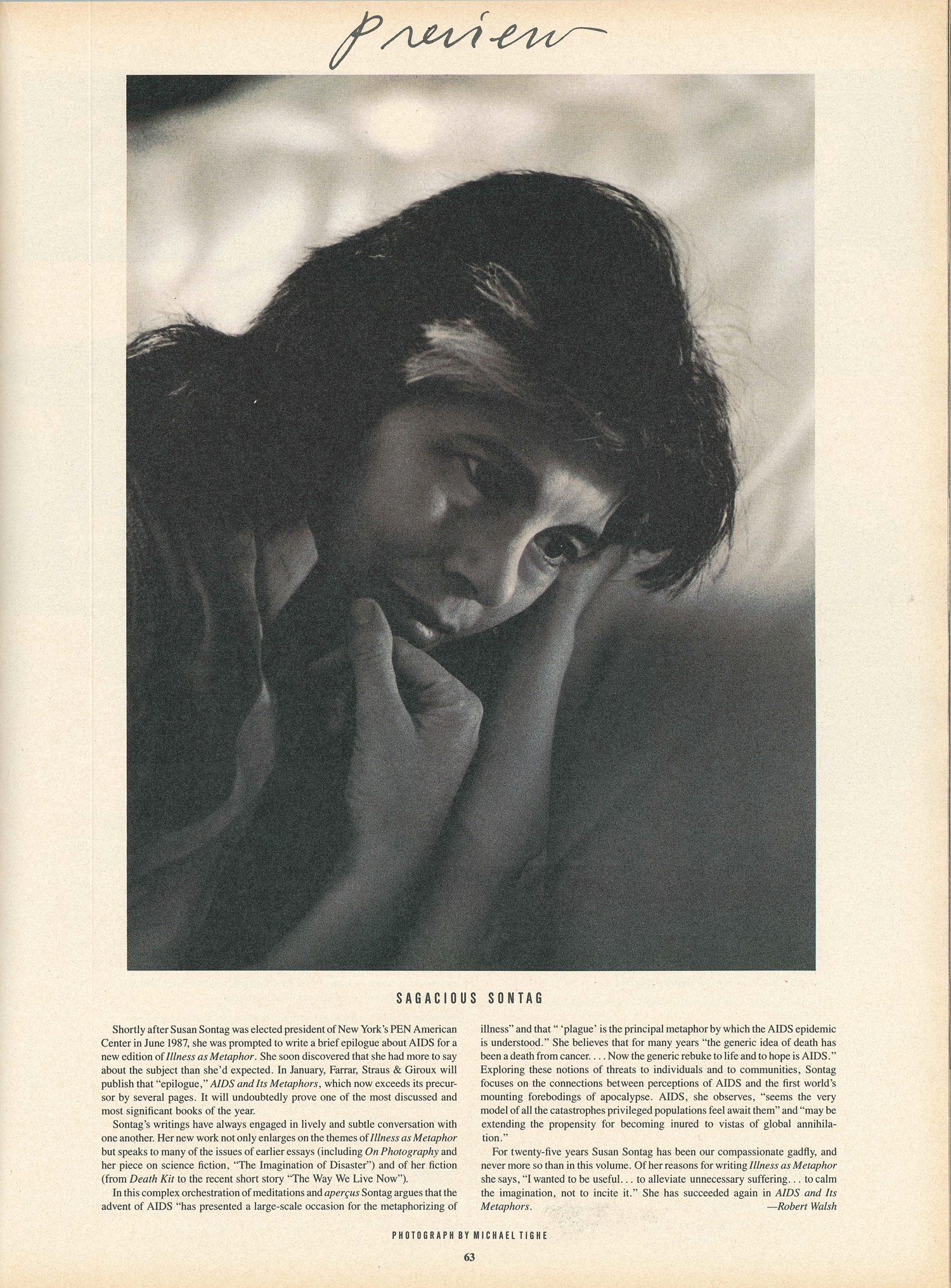
A profile of Susan Sontag in the December 1988 issue of Interview, with a portrait by Michael Tighe, on the publication of her book AIDS and Its Metaphors, a timely epilogue to her breakthrough work Illness As Metaphor.
The all-encompassing doorstopper biography lends itself to subjects of certain professions: politicians, explorers, movie stars. Writers, even the best ones—especially the best ones—by the very nature of their practice, reading, writing, and sitting at a desk for 12 hours at a stretch for years on end, are not ideal candidates for such sweeping life treatments. One of the few proven exceptions is the colossus of American letters Susan Sontag, who may be the closest the literary world got in the last half of the 20th century to a politician, explorer, and movie star. Sontag was many things to many people—beloved and hated, adored and maligned, almost never outsmarted or overlooked, she was truly the nation’s last famous public intellectual. Sontag was, like most American heroes, entirely self-made. She was born Susan Rosenblatt in New York City in 1933, but grew up primarily in Tucson, Arizona, and the San Fernando Valley of Los Angeles. An early sense of outsiderness mixed with a keen intellect and a hunger for art and philosophy eventually pushed Rosenblatt (turned Sontag thanks to her mother’s second marriage) into the geographic heart of the mid-20th-century avant-garde: New York City. The rest is the stuff of legend.
In essay after essay, Sontag redrew the cultural battle lines. She fearlessly conflated high and low culture, most famously in her gay-friendly 1964 essay Notes on ‘Camp’ (the fashion extravaganza at the Met owes her more than a nod of gratitude). She took on the subject of photography, as a weapon and as memento mori; she tackled the vital question of human suffering, empathy, and complicity; she riled against the Nazi filmmaker Leni Riefenstahl, helped reframe the conversation away from victim-blaming for diseases such as cancer and AIDS, and time and again championed bohemian writers, thinkers, artists, and filmmakers who wouldn’t have otherwise made a dent in the United States.
Sontag was a powerhouse, a proud aesthetic snob, a lover of beauty, a teller of truths—as well as a savvy truth-bender—and she had the photos to prove it. Her portrait was shot by the likes of Richard Avedon, Peter Hujar, Robert Mapplethorpe, and Andy Warhol (she also appeared several times in the pages of Interview). The white streak in her long black mane was as recognizable around town as Warhol’s wig. But Sontag was no existential saint. She was ruthless in her judgments. She made enemies easily, many of whom once considered themselves among her close friends. She was deeply uncomfortable with her sexuality and never publicly acknowledged her lesbianism. All of these and many more conflicting characteristics make for a tricky high-wire walk for even the most expert of biographers.
Amazingly, the writer Benjamin Moser has managed the near-impossible feat of capturing Sontag in all of her dark brilliance and pointed contradictions in his new book, Sontag: Her Life and Work (Ecco). Sontag’s work was her life, her life her work, and yet, with his immense research and intensive interviews with friends, adversaries, lovers, and living witnesses, Moser has managed to create a high-definition portrait not only of Sontag the stylish, cerebral New York icon, but also Sontag the blinking, blood-and-bone human. To talk about his elusive heroine and the hole that her passing in 2004 made on American culture, Moser spoke with the writer Gary Indiana, who once counted himself among Sontag’s close friends (Indiana approximates their friendship having run from 1979 to 1987). Sontag may or may not have argued with any of the following assessments. –CHRISTOPHER BOLLEN
———
GARY INDIANA: The book is a real tour de force. There are many things in there I didn’t know about Susan. And I knew her quite well, of course, up until a certain point, and then we didn’t see each other anymore. Can you talk about the process of getting people to talk to you?
BENJAMIN MOSER: I talked to hundreds of people—including you. One person said they’d need nine hours to talk about Susan and we ended up talking for longer than that. In my last book [Why This World: A Biography of Clarice Lispector], a lot of the people I interviewed were refugees or people unaccustomed to talking to journalists. Susan’s friends were the opposite. Still, you’d be surprised how many people—some very famous people—hadn’t had the opportunity to tell their story, so I often became a confidant. It’s not like most of these figures have grandchildren who say to them, “Oh, Grandma! Tell me about the time you went to the movies with Susan Sontag.” Overall, I think a lot of people had a relationship to Susan that was similar to yours—they saw her good sides and got close to her, and then something changed and they weren’t close anymore.
INDIANA: There’s a joke in your book about how many shrinks in New York were kept busy by people dealing with Susan’s behavior.
MOSER: A lot of people simultaneously loved her and kind of hated her.
INDIANA: That was the conundrum with Susan. And it wasn’t always possible to take the bad with the good. I remember when Susan was seeing a shrink while going through all of that business with Lucinda [Childs, a former girlfriend] and getting, in my view, quite deranged. I asked her how the shrink was going and she said, “Oh, he’s wonderful. We spent a whole session talking about Tatyana’s letter in [Pushkin’s] Eugene Onegin!” And I said, “Susan, that’s not what you go to a shrink for!”
MOSER: But maybe that was the reason for her! I think Susan needed to find a way to keep talking about Onegin more than she needed to find a way to reckon with, say, her issues with her mother.
INDIANA: Her mind was really spinning off its reel, and she did need some kind of help. I’m not sure that talking about Onegin was the help she needed. That’s just my opinion. But, yes, I do think Susan had a lot of unresolved issues with her mother. I remember when she came back from Hawaii after her mother died. She was full of bitterness and anger. Apparently, when she got to her mother’s bedside, her mother said, “What are you doing here?” Although, according to your book, that’s not exactly how it went.
MOSER: Well, I think Susan envisioned events in her life a bit like an opera. She novelized her experiences, like so many writers do. But I think she was sometimes surprised by the actual responses, like her ex-husband’s real response to her wanting to leave him—you can never fully art-direct the moment when you tell someone you’re getting a divorce. And I think the same was true with her mother in Hawaii. Susan had a novelist’s expectation about how certain events are meant to go in life. We know she rewrote events from her life and added fiction, like the essay she wrote about meeting Thomas Mann as a girl. That essay is really about her mother and her own sexuality. But you can see how she is taking something that happened to her and converting that reality into a metaphor. It’s similar to her cancer. I’d argue that her non-accurate recounting of her illness is actually more useful than a journalistic blow-by-blow. A lot of people kept fighting through their own illnesses because of Susan’s accounts. That’s what’s so fascinating about her fictionalization of herself.
INDIANA: I agree that giving certain experiences the form she did, whether it was true or not, was very helpful to people. It was generative. I will say it was sad for me to read that she bought into a lot of the myths that she was supposedly dispelling. But that’s a human thing to do, isn’t it?
MOSER: She’s such an extreme example of so many things that humans do. They need metaphor to make sense of their experiences. They need to read books and go to the opera and watch television to try to figure out how people live.
INDIANA: I think that there is a big difference between Susan’s approach to personal material and what’s prevailing now. Susan’s stance of a studied detachment is much more appealing to me than the kind of confessional literature that’s everywhere today. Everything is autobiography now, and it’s not helpful to people. It’s only helpful to the people writing the autobiographies.
MOSER: When you read Susan’s most impersonal essays, you see the core of who she is. She may have processed the experience into making it as dry as it can be, but it has this amazing energy of her wisdom and intellect lurking behind it. The last thing she was working on at the very end, when she was dying in New York, was an introduction to a work by [the Icelandic writer] Halldór Laxness. In it she writes, “Don’t be personal. Be dry. Write in the third person as much as possible.” I think that’s the key to the seduction of her writings.
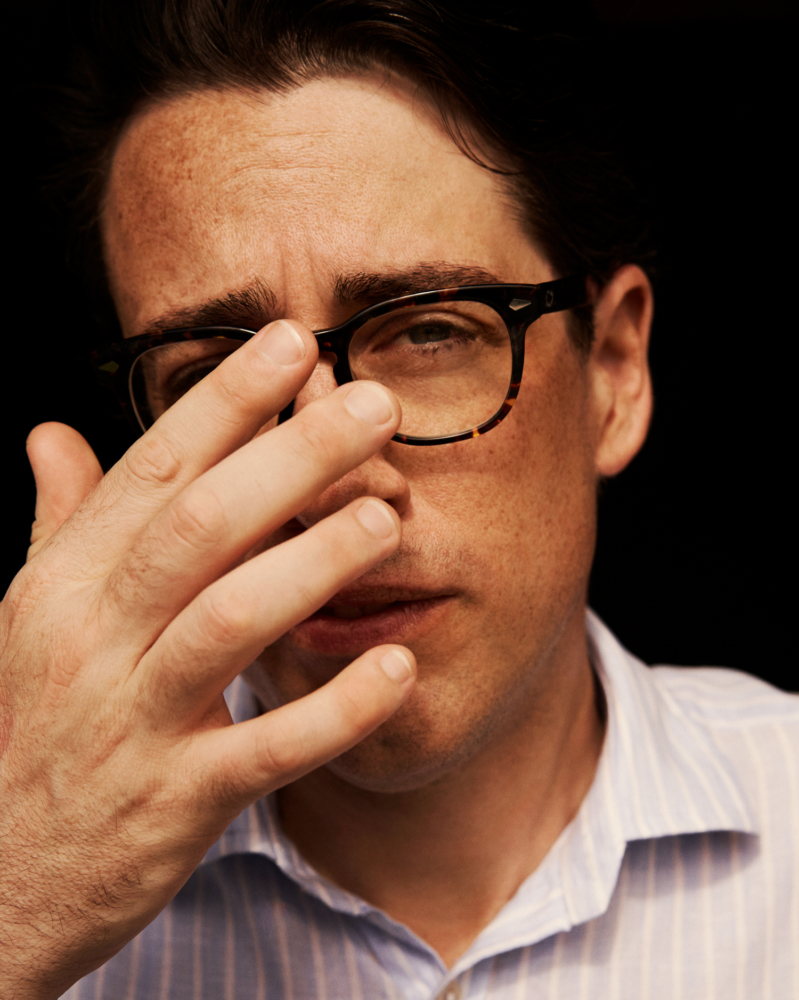
A portrait of Benjamin Moser by Cedric Viollet.
INDIANA: Oh, god, that brings up the thing that she seems to have been criticized for the most, and I always felt completely sympathetic to her position. That thing was not declaring that she was a lesbian, not declaring what her sexuality was. People were always clamoring for her to declare herself. I don’t think anyone has the right to demand that kind of proclamation from somebody else. And that puts me, I guess, in a very small minority of gay writers. Private and public are all breaking down so completely that people feel they have the right to speak for anybody else.
MOSER: I devote a lot of space in the book to that question of her sexuality. The critique of the closet really emerges in the 1980s. It’s there before, but in the ’80s it becomes a mandate that it’s important for gay people to have visible role models. I mean, nobody knew that Liberace was gay or that Rock Hudson was gay? It was complete denial. But more to the point, when you look at her romantic relationships, they’re always so conflicted. They’re really upsetting, unhappy—it’s always heartbreak, heartbreak, heartbreak. The question is, did she ever expect to be happy? The answer is that she didn’t ever expect happiness from the time she was a little girl.
INDIANA: It got to a point where her evasions became ridiculous. And yet, the stigma doesn’t leave you when you declare yourself. I mean, I was never in the closet, ever. But as a writer, my sexuality is not really my subject. And I think she probably felt the same way.
MOSER: As a biographer, when you’re actually going through her relationships with Harriet and Irene and Carlotta and Annie, one after the next, they all kind of end in the same way and they all become really unhappy. You’d think part of that is the fault of a homophobic world where straight people don’t have to declare themselves. But there was a change in the responsibility of public figures when AIDS came along because a lot of people who felt the way she did, who felt that “this isn’t anybody’s business,” were forced out of the closet because they got this disease that was identified with their sexuality. That goes right into Susan’s writing on two other diseases of sexual repression, which are tuberculosis and cancer. I had no idea until I started working on this book that cancer was once associated with sexual repression.
INDIANA: When I was growing up, if someone had cancer, you never spoke of it. It was just like being a homosexual. If it was spoken, it was done so in very hushed terms and there was a very punitive narrative attached to it. I think Susan’s Illness as Metaphor [1978] was so helpful to countless people because it took the stigma out of the disease. You know, there was a long period in America when doctors wouldn’t even tell their patients that they had cancer.
MOSER: Clarice Lispector died of cancer in 1977, which is two years after Susan got cancer, and she died without ever having been told that she had the disease. I was born in 1976 and grew up in a world where I never heard that connection at all, and I think a lot of that is thanks to Susan. I wouldn’t say 100 percent, because obviously the culture was changing in general about what you tell patients and what rights they have. But one of the interesting things about writing this book is just how much the awareness of these subjects changed in just a few decades. I would say that certainly includes homosexuality.
INDIANA: I found most of her writing around AIDS to be very bizarre, frankly—even her short story [The Way We Live Now, 1986], which she read to me on the phone. I said, “Don’t you think Robert’s going to hear about this?” It was so clearly about Robert Mapplethorpe. And she said, “Well, he’s a big user. He’ll understand.”
MOSER: Yeah, and maybe he did! But what was so bizarre about that to me was that she insisted that the story was not only not about him but it wasn’t even about AIDS. And she said this even as she was contributing this story to AIDS charities for fundraising. I think the bigger argument about the closet and sexuality isn’t about whether people need to sign on the dotted line. It has a lot more to do with why I put [the poet and feminist activist] Adrienne Rich’s critique of Sontag in the book. It’s the difference between saying “my body” versus “the body,” and that “my” was something that Rich felt was imperative for a woman writer. She thought it was very important for women specifically to say what they are actually talking about instead of just resorting to allegory. But I have two minds about all of this. I’m talking to you right now from Venice. And in Venice, if you paint a ceiling with a nymph giving somebody side-eye, you can make a very powerful political statement without doing anything but alluding to a scene from classical mythology. I love that. I don’t think everybody needs to publish an open letter in The New York Times. But right now the culture is about the instant announcement of everything, as well as the instant denouncement. I think there’s room for both. There’s something sexy about a hint or a wink rather than a Macy’s Thanksgiving Day Parade.
INDIANA: I think Susan’s metaphorical imperative got to be a bit too much after a certain point.
MOSER: That’s the other side of metaphor. Metaphor can fade into dishonesty. At its best, it can lead to very interesting confusions. It’s like Susan’s relationship to photography. Some people thought she hated photography. Some people thought she loved it.
INDIANA: I think it was both. She was fanatically interested in photographs. I remember her telling me once that she couldn’t see things unless they were photographed. She was a non-visual person, but if something was depicted in a photograph, then she would see it.
MOSER: A lot of people told me that she couldn’t really hear music and couldn’t really see painting. She really was 100-percent literary. She told her son, David, when he was a kid that he wasn’t allowed to look out the window while they were traveling by train.
INDIANA: Really? Why?
MOSER: She’d say to him, “What are you looking at? All you need to know about this place you can find out through books.” And that, of course, is not true. But it is also sort of true. You know more about what you’re looking at if you have read about it. She was an extreme personality in that she needed the photograph. She needed the metaphor in order to see what she was seeing.
INDIANA: I was thinking this morning about Against Interpretation [1966] and Styles of Radical Will [1969], and all of the criticism mounted against her at the time—like how she made everything equivalent or how she destroyed the difference between high culture and low culture, which to my mind could only be a positive development. But there’s a conservatism that creeps in later on. She mostly only wrote about stodgy old white men. I also have the feeling that she just lost interest in what was going on unless it was in this very rarefied sphere of opera or literature.
MOSER: You can think about her work within the chronology of when it was written. Many of the essays in Against Interpretation were written in the early 1960s. That’s a really hopeful time, when all this youth culture is coming up and people think the world is going to get better and there’s Martin Luther King Jr. and John F. Kennedy. By the end of that decade, there’s a real darkness that creeps in with the Vietnam War and everything else. When you look at what people called “conservative,” Susan said she was conservative with a small “c” in the sense that she was the girl in Tucson, Arizona, who read the books of the Modern Library. She liked reading Shakespeare and Dante, which are things that people were reacting against at the time, but, in some ways, later forgot about entirely. High culture, in so many people’s educations, stopped existing at all.
INDIANA: It’s the opposite of mass culture, which is pretty much all culture is today.
MOSER: Many places went from the Middle Ages to the internet without any stop in between. Culture has become just crap on Twitter. It’s Donald Trump, completely nihilistic. So now it’s not even that people don’t like Dante. It’s that they’ve never heard of Dante.
INDIANA: They’re barbarians. I mean that in a strict Friedrich Engels sense of barbarism as lapsing into savagery.
MOSER: That’s why I find Susan’s type of conservatism inspiring because it’s hard work. She writes about the difficulty of the mind and the complexity of ideas. And that’s something I find now is so desperately needed.
INDIANA: The state of the world right now is so depressing. But America has always been like this. It has never reached any point of civilization as far as I’m concerned. It’s a disaster of a country. When my older brother was going to high school, he had to take Latin and Greek. By the time I got to high school, you didn’t have to take any languages.
MOSER: Yeah, because what’s the point? There’s a valid argument that the failure is on the elites. The people who should have been making the case for learning Greek or reading Shakespeare didn’t. They went along with a culture that values things according to how much they cost rather than how interesting they are or how important they are. Maybe that idea is snobby and judgmental. But I think Susan was totally fine with being called both of those things. And I think culture misses having figures like that, don’t you?
INDIANA: Yes, one of the great blessings of being a friend of Susan’s was that you would find out about things you might not otherwise. We were always recommending books to each other. It was a very positive relationship in that respect.
MOSER: A lot of people felt that way—even people who didn’t know her personally. They’d glean these unknown books or films from her essays. Those of us now who are focused on books and art and theater and music can often feel like we are alone, just pissing into the ocean. And that’s why Susan is so exciting. She really made a difference. I don’t think any successor to Susan has really come along, someone who makes you feel like, “I can’t believe you didn’t see that opera, what’s wrong with you?” I would love someone like that to come along in the world and make people think, “Oh my god, you haven’t read Elizabeth Barrett Browning? What’s your problem?”
INDIANA: That’s right. There’s no figure whose judgment you trust.
MOSER: But that’s my hope in this book—that people are going to look at Susan and her work again and get interested in her, and actually take up the flame. The world has never needed a Susan Sontag more than it does now.


